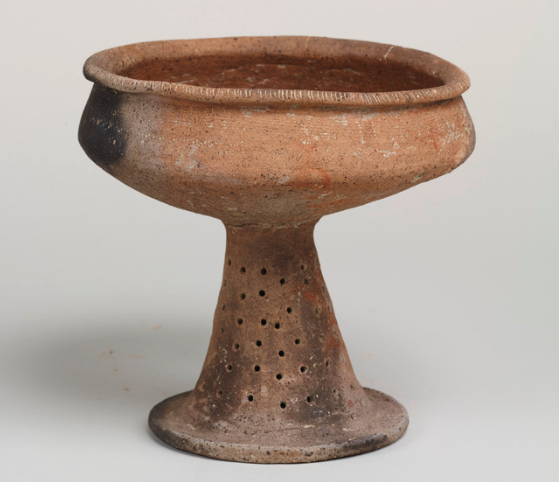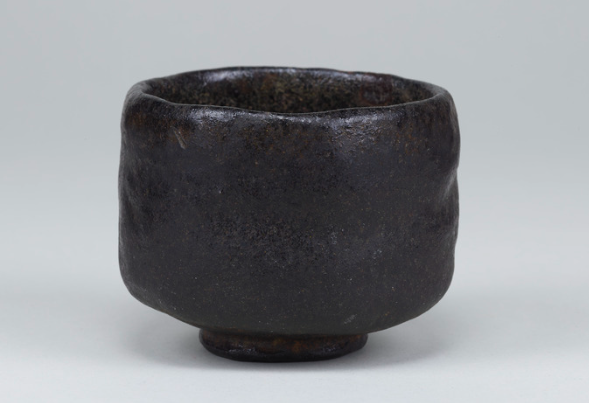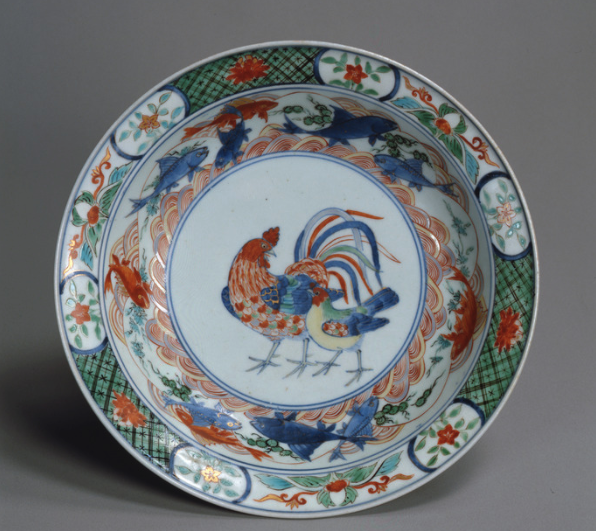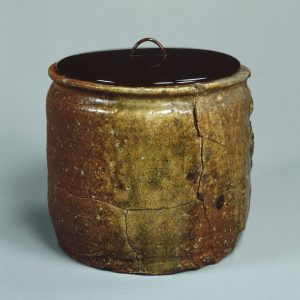There are two main types of ceramics. One is pottery, which is fired by kneading and hardening clay, and the other is porcelain, which is fired by crushing stones into a powder, adding water, and forming the powder into a paste.
The history of pottery in Japan is long, beginning with Jomon earthenware excavated in Aomori Prefecture 16,500 years ago. Next came Yayoi earthenware, produced from the 2nd century B.C. to the 3rd century A.D. Then came Sue ware from the Korean peninsula in the 5th century, which came to Japan along with a new technique of firing with a high-temperature reducing flame after shaping with a potter’s wheel.

Pottery from the Yayoi period (ca. 5th century BC–ca. 3rd century AD), during which rice cultivation began, was made for cooking, storage, and serving food. This footed bowl (高坏)was for serving. (from Colbase[https://colbase.nich.go.jp/])
In the latter half of the 7th century, glazed ceramics began to be fired, and in the latter half of the 10th century, during the mid-Heian period, the flame was changed from a reducing flame to an oxidizing flame, and from around the 12th century, at the end of the Heian period, it gradually began to be fired into mountain tea bowls, etc., and mass production became possible.
From the Kamakura to Muromachi periods, daily necessities such as jars and pots were mainly produced at specific kilns in Tokoname, Seto (Aichi), Bizen (Okayama), Shigaraki (Shiga), Tanba (Hyogo), and Echizen (Fukui). The above kilns are known as the Six Old Kilns.

Jar, Natural glaze with three lines design(自然釉三筋壺) (Tokoname ware/12th century/from Colbase[https://colbase.nich.go.jp/])
It was during the Azuchi-Momoyama period (Azuchi-Momoyama era), about 400 years ago, that Japanese ceramics and porcelain fully formed a unique Japanese culture. Along with the popularity of the tea ceremony, made famous by Sen no Rikyu, ceramics flourished in Mino (Gifu), Raku (Kyoto), Karatsu (Saga), and Hagi (Yamaguchi). Mino ware, in particular, produced many masterpieces in styles such as Shino, Oribe, and Kiseto.In the Edo period (1603-1867), a great deal of pottery was produced in Seto, and even today, many people in Japan refer to ceramics as Setomono.

Raku tea bowls were originated by Chojiro, who was inspired by the tea master Sen no Rikyu. The bowls are shaped by hand without using a potter’s wheel, and are then shaved with a spatula. The black glaze is completely covered up to the base of the vessel, and the tranquil appearance of the vessel reflects the spirit of the times, which demanded a sense of dignity and serenity. Kuro-Raku tea bowl ”The Old Tale”(黒楽茶碗 銘むかし咄)(/16th century/from Colbase[https://colbase.nich.go.jp/]))
Porcelain was first produced in Arita, Saga Prefecture, by potters brought from Korea. The reason for this is that good-quality magnets, the raw material for porcelain, can be mined in Arita. Arita porcelain was then exported in large quantities from the port of Imari to the rest of Japan, hence the name Imariyaki. Among them, high-end items, such as masterpieces in the Kakiemon style of color painting, were exported to Europe via the East India Company. Even today, Imariyaki porcelain that crossed the sea 300 years ago can be seen in royal palaces and old castles in the Netherlands and Germany.

Shallow Bowl, Fowl design in overglaze enamel(色絵鶏文平鉢) (Imari ware/18th century/from Colbase[https://colbase.nich.go.jp/])
Japanese porcelain spread throughout the country throughout the Edo period, and porcelain is still actively produced today in the aforementioned Mino, Seto, Kutani (Ishikawa), and Tobe (Ehime).Japanese porcelain patterns can be broadly classified into three types: white porcelain (white bare), Sometsuke (blue painting on white bare, blue-and-white), and Iro-e (painting in red, blue, green, purple, yellow, etc.). This is also true of modern tableware, which has remained almost unchanged for 300 years. And the most popular and widely used type is Sometsuke, which has a cool atmosphere.
There are some famous ceramics in the world. Jingdezhen in China, Meissen in Germany, Wedgwood in England, Limoges in France, and Ginori in Italy, to name a few. All of them have produced beautiful pottery using the best techniques, but the major difference between them and Japanese ceramics is that each piece is beautiful on its own. In other words, beauty is complete in a single vessel.
In contrast, Japanese ceramics are made with the expectation that the main subject of the piece will be another object, such as tea for a tea bowl, flowers for a flower vase, or food for tableware. The shape, color, and pattern are all tools to enhance the main subject, and the presence and ease of use of these tools are intended to be a supporting role. The origin of this concept can be traced back 400 years to the flourishing of the chanoyu tea ceremony.

This is a fine example of a Shigaraki-ware water jar. Water jars are used during tea ceremonies to store water. They are used with a lid in the tea room. The crack in front and burnt section on the side create a powerful impression. Water Jar with a Flush Rim, Named “Shiba no Iori (Grass Hut / 一重口水指 銘 柴庵)” (Shigaraki ware/ 16th-17th century/from Colbase[https://colbase.nich.go.jp/])
The spirit of the tea ceremony is for the master to entertain his guests with his ingenuity and to enjoy the once-in-a-lifetime experience through a cup of tea, and it is outrageous for the utensils to play a leading role in the ceremony.
Most of the ceramics used by Japanese people today are influenced by these traditional production areas and styles and are based on any part of the motif. Beautiful and easy to use. This is perhaps the greatest appeal of Japanese ceramics.

